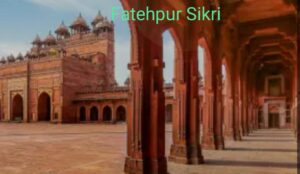Nestled in the heart of Uttar Pradesh, Fatehpur Sikri stands as a testament to the architectural brilliance and cultural amalgamation of the Mughal era. This historic city, founded by Emperor Akbar in the late 16th century, offers a window into the grandeur and innovation of its time. Today, Fatehpur Sikri is recognized as a UNESCO World Heritage Site, attracting history enthusiasts and tourists from around the globe.

1.Fatehpur Sikri: Historical Background
The story of Fatehpur Sikri begins in 1571 when Emperor Akbar decided to establish a new capital city. The location was chosen to honor the Sufi saint Salim Chishti, whose blessing Akbar believed had led to the birth of his son, Jahangir. Over the course of the next fifteen years, the city blossomed into a magnificent urban center, complete with palaces, mosques, and public buildings. However, due to water scarcity and other logistical challenges, Fatehpur Sikri was abandoned as the Mughal capital in 1585, just fourteen years after its completion.
2.Fatehpur Sikri: Architectural Marvels
Fatehpur Sikri is renowned for its unique blend of Hindu and Islamic architectural styles, reflecting Akbar’s vision of a syncretic cultural landscape. Among its many architectural wonders, the following structures stand out:
– Buland Darwaza: This imposing gateway, built to commemorate Akbar’s victory over Gujarat, stands 54 meters high and serves as the main entrance to the city. Its grandeur and intricate carvings are a sight to behold.
– Jama Masjid: One of the largest mosques in India, the Jama Masjid is an architectural marvel with its vast courtyard and stunning domes. It remains a place of worship and a symbol of the city’s religious harmony.
– Tomb of Salim Chishti: Located within the Jama Masjid complex, this white marble mausoleum is a revered shrine. It attracts thousands of devotees who come to seek blessings and pay homage to the Sufi saint.
– Panch Mahal: This five-storied palace, with its open-sided pavilions, offers panoramic views of the city. It was designed to catch the breeze and serve as a place of relaxation for the royal family.
– Diwan-i-Khas and Diwan-i-Aam: The halls of private and public audience, respectively, where Akbar held court. The Diwan-i-Khas is particularly famous for its central pillar with intricate carvings and a platform that once supported Akbar’s throne.
3.Cultural and Religious Significance
Fatehpur Sikri was not just an administrative center but also a cultural and religious hub. Akbar’s policy of religious tolerance and his interest in diverse faiths found expression here. The Ibadat Khana, or House of Worship, was a place where scholars of different religions debated theological and philosophical issues. This inclusivity and openness were hallmarks of Akbar’s reign, contributing to the cultural richness of the Mughal Empire.

4.Architectural Features and Innovations
The architectural features of Fatehpur Sikri reflect a confluence of Persian, Indian, and Islamic styles. The city’s layout demonstrates advanced urban planning, with a grid system of streets, efficient water management through tanks and wells, and buildings strategically placed to optimize natural light and ventilation. The intricate carvings and inlaid designs on red sandstone structures showcase the artistic prowess of the craftsmen of that era.
5.Current Status and Preservation Efforts
As a UNESCO World Heritage Site, Fatehpur Sikri benefits from international attention and conservation efforts. Restoration projects aim to preserve its architectural integrity and historical significance. However, challenges such as weathering, pollution, and the sheer volume of tourists require ongoing vigilance and sustainable management practices.
6.Tourist Experience
Visiting Fatehpur Sikri is like stepping back in time. Tourists can explore its many wonders, each telling a story of the city’s past glory. Key attractions include the Buland Darwaza, Jama Masjid, and the royal palaces. To fully appreciate the site’s history and architecture, guided tours are recommended. The best time to visit is during the cooler months, from October to March, to avoid the harsh summer heat.
Conclusion:
Fatehpur Sikri remains a jewel in India’s rich historical tapestry. Its architectural splendor, cultural significance, and the story of its rise and fall under Emperor Akbar make it a fascinating destination. For anyone interested in the Mughal era or Indian heritage, a visit to Fatehpur Sikri offers an unforgettable journey through time, showcasing the ingenuity and grandeur of one of India’s greatest empires.
FAQ:
1.Where is Fatehpur Sikri and why is it famous?
2.Whose tomb is in Fatehpur Sikri?
3.Which fort is in Fatehpur Sikri?
4.Why did Akbar build Fatehpur Sikri?
5.Fatehpur Sikri history
6.Fatehpur Sikri information in english
7.fatehpur sikri – wikipedia
8.10 lines on Fatehpur Sikri in english
9.Who built Fatehpur Sikri
10.Fatehpur Sikri Live

